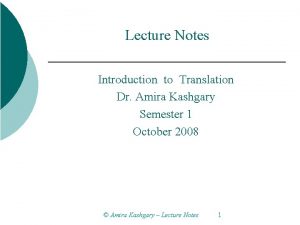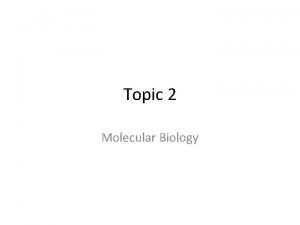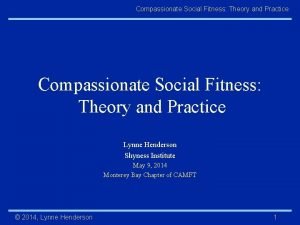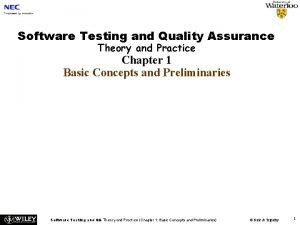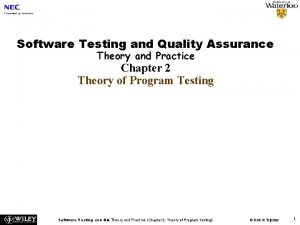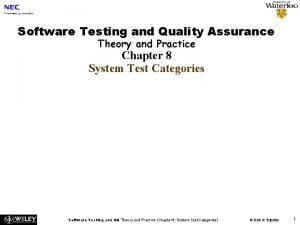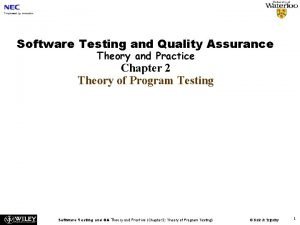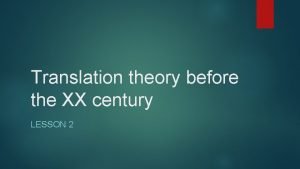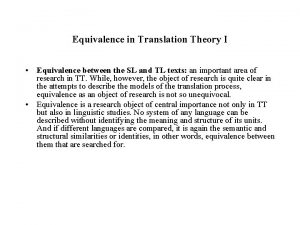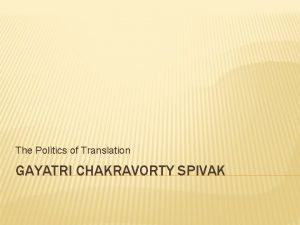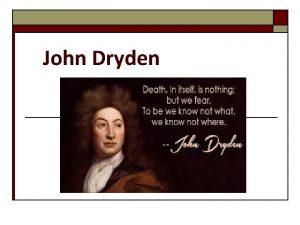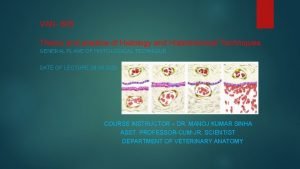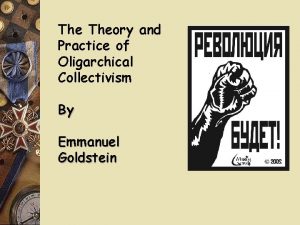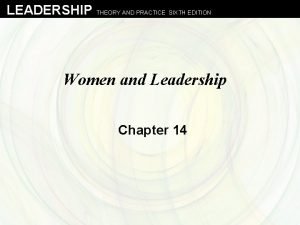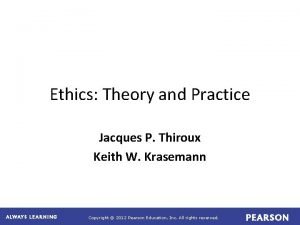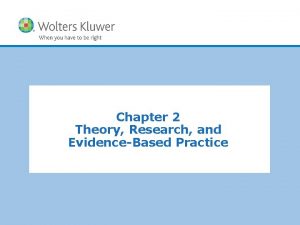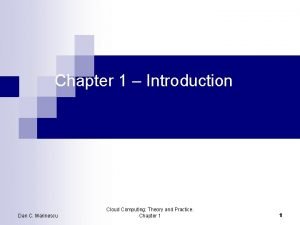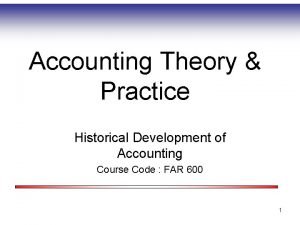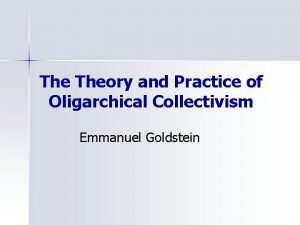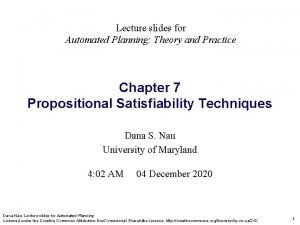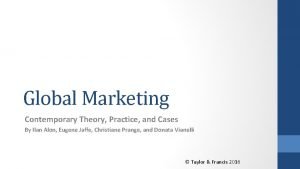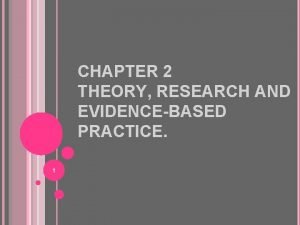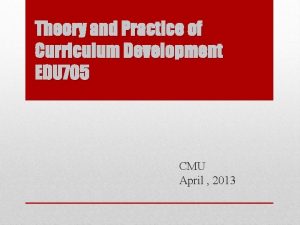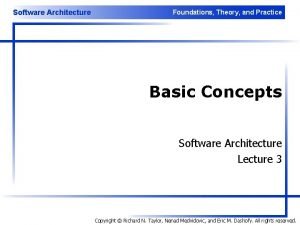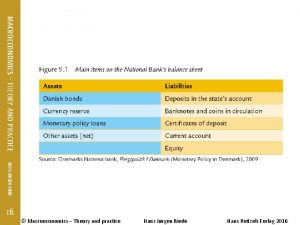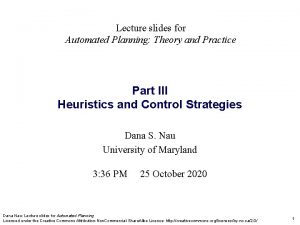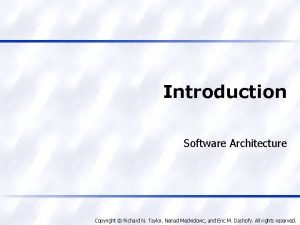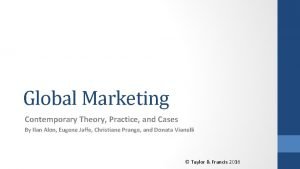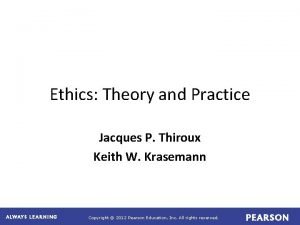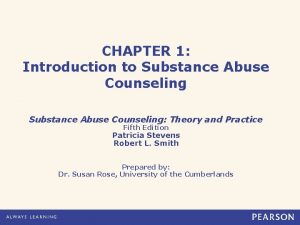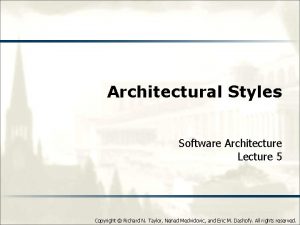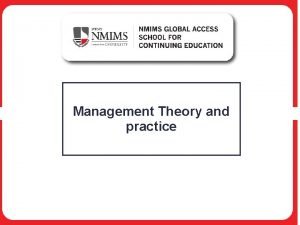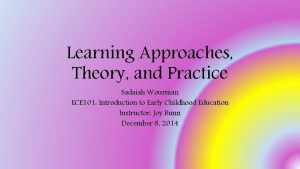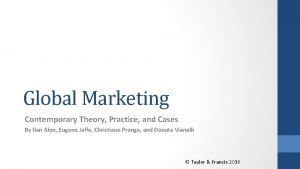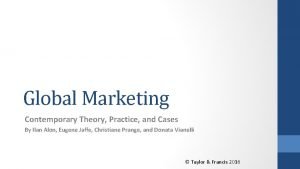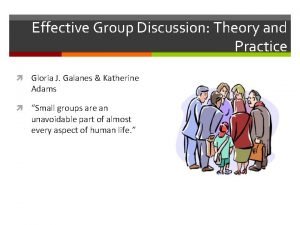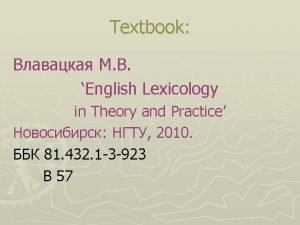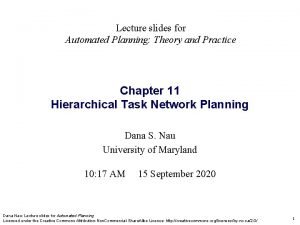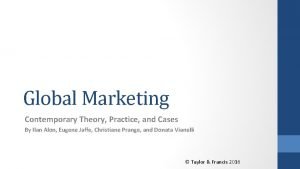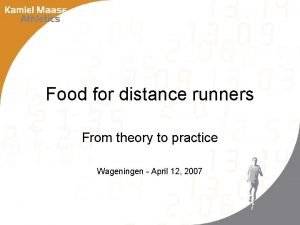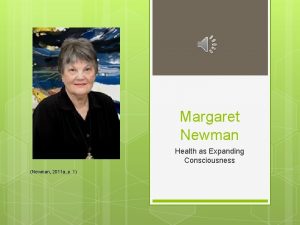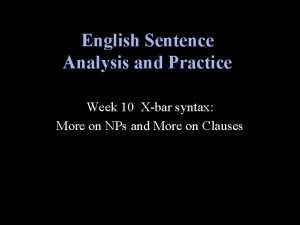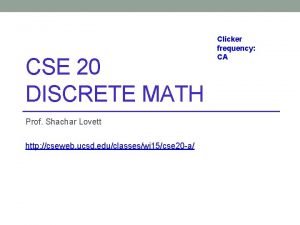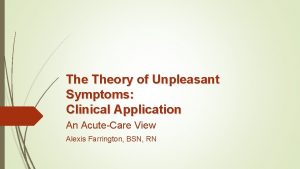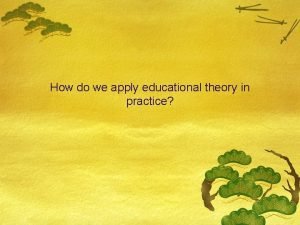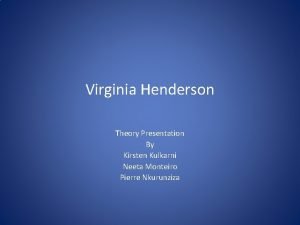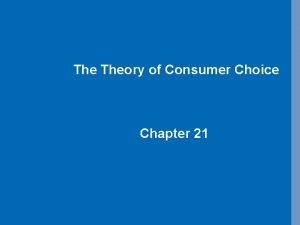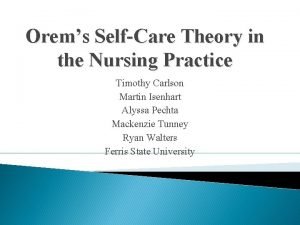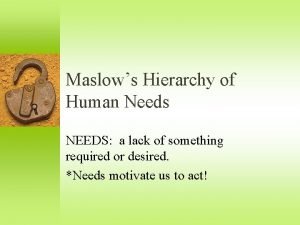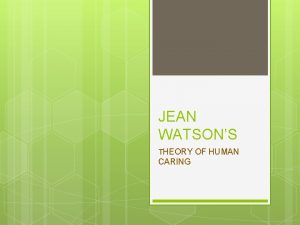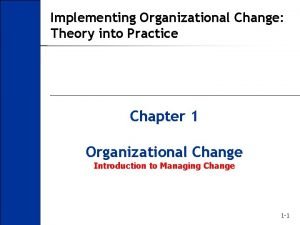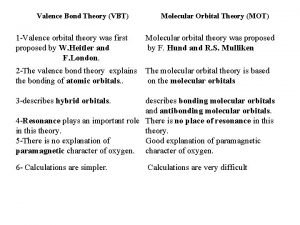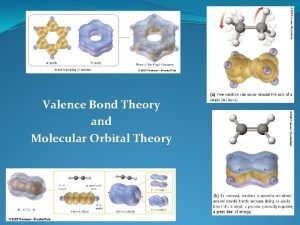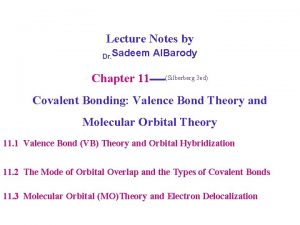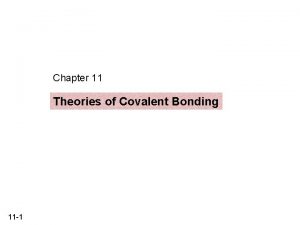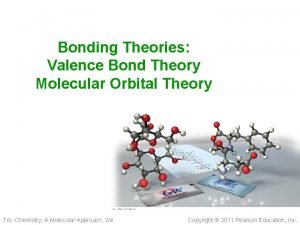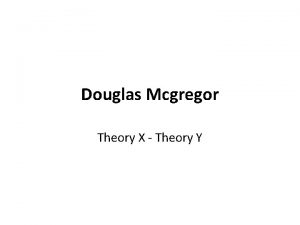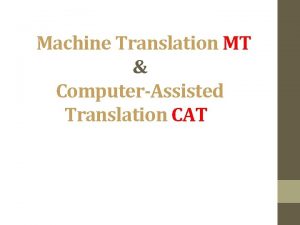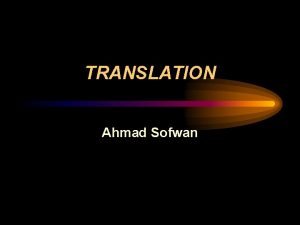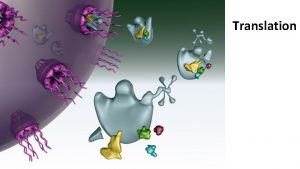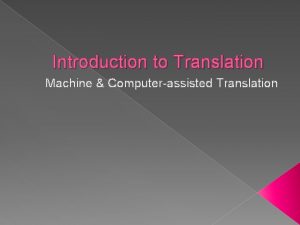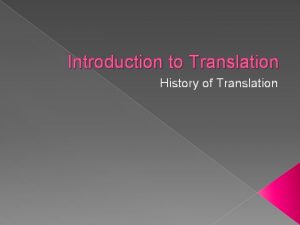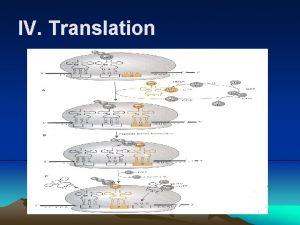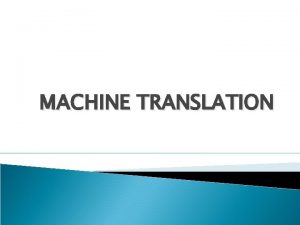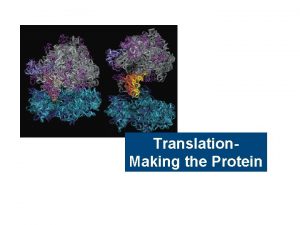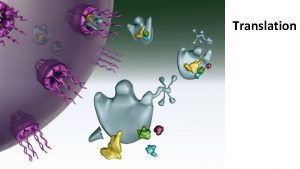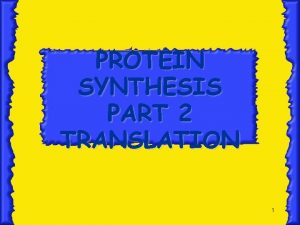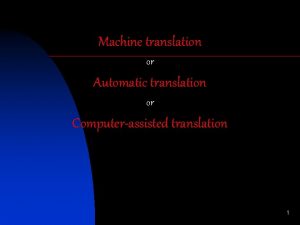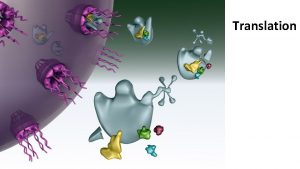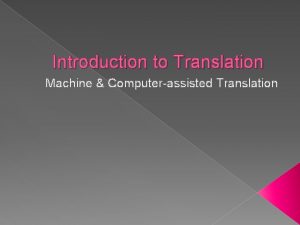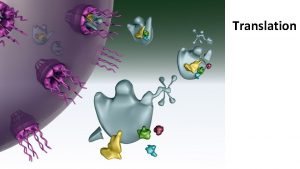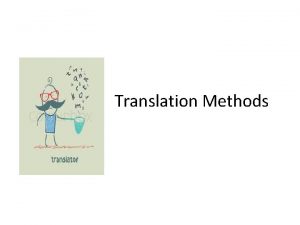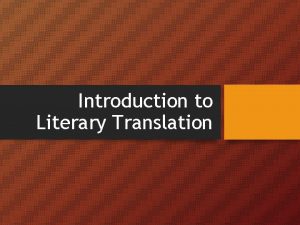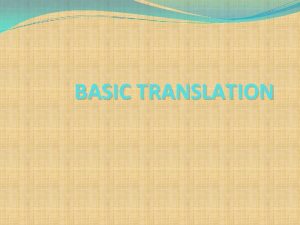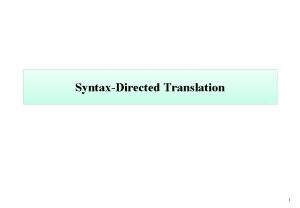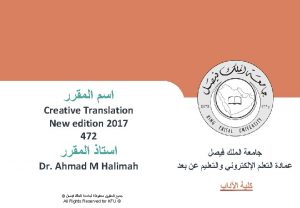Lecture 7 Theory and practice of translation in































































































- Slides: 95

Lecture 7 Theory and practice of translation in the 20 th and early 21 st century

Theory and practice of translation in the 20 th and early 21 st century 1. James Fitzmaurice-Kelly’s entry on translation in Encyclopaedia Britannica (1911). 2. Ezra Pound and his influence on poetic translation in the 20 th century. 3. Translations of Russian classics by Constance Garnett. 4. Walter Benjamin and his essay “The Task of the Translator”. 5. Roman Jakobson and his essay “On Linguistic Aspects of Translation” 6. Jiří Levý’s concept of literary translation. 7. Theodore Savory’s “The Art of Translation”. 8. John Catford’s “A Linguistic Theory of Translation”. 9. Eugene Nida’s theory of “dynamic” or “functional equivalence”. 10. Peter Newmark’s contribution to theory of translation. 11. Vladimir Nabokov’s translation activity. 12. Mary Snell-Hornby’s integrated approach to translation studies. 13. Lawrence Venuti and “translator’s invisibility”. 14. Translation studies in the 20 th-century Russia.

James Fitzmaurice-Kelly’s entry on translation in Encyclopaedia Britannica (1911). A general entry on translation in the 11 th edition of Encyclopaedia Britannica in 1911 was written by James Fitzmaurice. Kelly (1857– 1923), Professor of Spanish Language and Literature at the University of Liverpool. (for self-study)

Ezra Pound and his influence on poetic translation in the 20 th century. Ezra Pound (1885– 1972)

Ezra Pound and his influence on poetic translation in the 20 th century. When he began translating and writing about translation in the 1910 s, the translation of older poetry into English was dominated by the use of pseudoarchaic English. Words like ‘hath’ and ‘methinks’ were meant to indicate the age of the source text.

Ezra Pound and his influence on poetic translation in the 20 th century. In the hands of good poets like Dante Gabriel Rossetti and Charles Swinburne, the method produced glamorously romantic translations. Inferior poets produced translations which made the great poets of the past sound all alike and equally irrelevant to the present.

Ezra Pound and his influence on poetic translation in the 20 th century. Ezra Pound is remembered as the translator and theorist who broke that tradition. His letters and essays urged translation into fully modern English and advocated free verse as an English equivalent to quantitative or syllabic verse. His influential translations taught translators how to use a neutral modern, semi-formal diction to convey a simultaneous sense of antiquity and timelessness.

Ezra Pound and his influence on poetic translation in the 20 th century. Pound experimented with using a specific earlier period of English, or with mixing different periods on purpose, to call to mind the world-view of its particular time and convey ideas not available to modern English.

Ezra Pound and his influence on poetic translation in the 20 th century. In contrast to the anti-translation attitude to poetry (‘Poetry is what is lost in translation’), Pound advocated respect for the English tradition of translation, calling attention particularly to the beauties of Elizabethan translation.

Ezra Pound and his influence on poetic translation in the 20 th century. He pointed out that Elizabethans saw earlier literature not as a set of words to be faithfully reproduced, but as a set of ideas to be absorbed and refashioned.

Ezra Pound and his influence on poetic translation in the 20 th century. For Pound, translation is a form of criticism, its purpose for readers is to point out and make accessible works of importance; its purpose for writers is to help them, in their struggle to match the voice of another, to find their own.

Translations of Russian classics by Constance Garnett (1861– 1946) translated a substantial portion of the classical (19 th-century) corpus of Russian literature, with the exception of its poetry.

Translations of Russian classics by Constance Garnett was responsible for the vogue for Russian writing in England. Constance Garnett’s translations made Russian literature accessible to an English language public.

Translations of Russian classics by Constance Garnett. Katherine Mansfield wrote to Constance Garnett: ‘My generation (I am 32) and the younger generation owe you more than we ourselves are able to realize. These books have changed our lives, no less. What could it be like to be without them!’

Translations of Russian classics by Constance Garnett. In particular, Garnett’s versions of Chekhov revolutionized the art of the short story, producing major influence on K. Mansfield and D. H. Lawrence.

Translations of Russian classics by Constance Garnett about translation: The qualifications for a translator are to be in sympathy with the author he is translating, and most important of all to be in love with words and interested in all their meanings. The language of a country is the soul of its people, and if you debase the language you debase the people and rob them of their heritage.

Translations of Russian classics by Constance Garnett about translation: The desire to modernise an author arises from ignorance of the past and from bad taste. I have always tried to translate the Russians into the language of the period in which they wrote, which is of course possible with Russian literature, since it is all relatively modern. It would show grotesque insensibility to produce a translation of Gogol’s Dead Souls, written at the same time as Pickwick, in the language of today’s newspapers. I am particularly proud of having translated Dead Souls into English of the period in which it was written.

Translations of Russian classics by Constance Garnett about translation: I agree there are obvious limits to this: there would be no advantage in trying to translate ‘The Odyssey’ into the language of Chaucer—on the other hand no one would want to translate it into modern slang. Thus with Dead Souls, one cannot translate the language of Russian serfs before their emancipation into that of the proletariat of today. One’s aim should always be to translate into the language of the corresponding way of life.

Walter Benjamin and his essay “The Task of the Translator” Walter Benjamin (1892– 1940), German-Jewish essayist and translator, set down his thoughts on translation theory in his pivotal essay “The Task of the Translator” (1923).

Walter Benjamin and his essay “The Task of the Translator” W. Benjamin argues that translation which only renders the meaning is bad translation. The question of a work’s ‘translatability’ is twofold. It can mean: will the work ever find its proper translator among all its possible readers; or—and more to the point—does it, by its nature, permit translation?

Walter Benjamin and his essay “The Task of the Translator” W. Benjamin sees the ultimate purpose of translation in expressing the innermost relation between languages. He further argues that this purpose can be realized as languages are related in that which they wish to say.

Walter Benjamin and his essay “The Task of the Translator” The task of a translator is to find in the translator’s language that hidden structure which can awake an echo of the original. W. Benjamin emphasizes that fidelity in the rendering of individual words can almost never carry over fully the sense they have in the original, as the sense of individual words acquires significance only in connection with the manner of expression.

Walter Benjamin and his essay “The Task of the Translator” In particular, literalness in regard to syntax destroys any rendering of sense whatever and results in unintelligibility.

Roman Jakobson and his essay “On Linguistic Aspects of Translation” Roman Jakobson (1896– 1982), literary theorist and linguist, in his essay ‘On Linguistic Aspects of Translation’ extends the significance of translation to include intralingual and intersemiotic translation.

Roman Jakobson and his essay “On Linguistic Aspects of Translation” Three ways of interpreting a verbal sign: it may be translated into other signs of the same language (intralingual translation), into another language (interlingual translation), or into another, nonverbal system of symbols (intersemiotic translation).

Roman Jakobson and his essay “On Linguistic Aspects of Translation” Jakobson’s emphasis on the functional role of linguistic elements in the translated text had a positive effect on the work of poetry translators. Regarding poetry by definition as untranslatable, Jakobson believed in the inevitability of ‘creative transposition’.

Jiří Levý’s concept of literary translation. Jiří Levý (1926– 1967), a Czech theorist and historian of literature “The Art of Translation” (1963)

Jiří Levý’s concept of literary translation. Levý places literary translation within a general communicative theory of translation. As the translator cannot bring everything across, it is important to decide firmly what elements of the work must be preserved in order for it to function as a whole in its new language.

Jiří Levý’s concept of literary translation. Translation is a hybrid phenomenon, which involves contradiction between the foreign and the native. The translator’s task is to minimize the conflict, and to put together a textual whole which will function in its new context without calling too much attention to the fact that it is a translation.

Jiří Levý’s concept of literary translation. In his book he also talks about the ‘principle of realist translation’. “A good translator must above all be an efficient reader, a reader who refashions the work for another reader who is not to be made conscious of the kind of performance the translator is involved in. ”

Jiří Levý’s concept of literary translation. Levý compares translation to the performing arts, especially dramatic performance. He sees the Stanislawskian theatre training as the closest analogy to the education of a good translator.

Theodore Savory’s “The Art of Translation”. 1952 Theodore Savory published in London “The Art of Translation”

Theodore Savory’s “The Art of Translation”. Th. Savory differentiates between four types of translation: 1) perfect translation – translation of purely informative phrases; 2) adequate translation – translation of fiction, where it is the content that is relevant, not the manner of expression; 3) translation of classical works of literature, where the form is as important as the content; 4) translation of scientific and technical materials called for by practical needs.

Theodore Savory’s “The Art of Translation”. The essence of translation consists in making a choice. A translator has to answer consecutively three questions: 1) What did the author say? 2) What did he mean by that? 3) How it can be rendered?

Theodore Savory’s “The Art of Translation”. Object of translation content of the original form of the original the author’s communicative intention

Theodore Savory’s “The Art of Translation”. A translator should steer the middle course between literal and free translation, so that on the one hand, the translation reads like an original text, and on the other hand, it preserves fidelity to the source text. Th. Savory believes that a translator has the right to borrow successful findings of his predecessors.

John Catford’s “A Linguistic Theory of Translation”. John Catford “A Linguistic Theory of Translation: an Essay on Applied Linguistics” (1965).

John Catford’s “A Linguistic Theory of Translation”. Catford proposed very broad types of translation in terms of three criteria: 1. The extent of translation (full translation vs partial translation); 2. The grammatical rank at which the translation equivalence is established (rank-bound translation vs. unbounded translation); 3. The levels of language involved in translation (total translation vs. restricted translation).

John Catford’s “A Linguistic Theory of Translation”. Catford raises the issue of untranslatability with a new perspective. linguistic untranslatability difference between SL and TL cultural untranslatability absence of relevant situational features in the TL

John Catford’s “A Linguistic Theory of Translation”. John Catford was very much criticized for his linguistic theory of translation. One of the strongest criticisms came from Mary Snell. Hornby (1988), who considers that the concept of equivalence in translation is an illusion. She asserts that the translation process cannot simply be reduced to a linguistic exercise, as claimed by Catford, since there also other factors, such as textual, cultural and situational aspects, which should be taken into consideration when translating.

John Catford’s “A Linguistic Theory of Translation”. In other words, Mary Snell-Hornby does not believe that linguistics is the only discipline which enables people to carry out a translation, since translating involves different cultures and different situations at the same time and they do not always match from one language to another.

Eugene Nida’s theory of “dynamic” or “functional equivalence”. In 1964 Eugene Nida, American pioneer in development of theory and practice of Bible translation, first formulated the concept of “dynamic” or “functional equivalence” in translation, which was developed in numerous books and articles over the past decades.

Eugene Nida’s theory of “dynamic” or “functional equivalence”. “A translation of dynamic equivalence aims at complete naturalness of expression and tries to relate the receptor to modes of behavior relevant within the context of his own culture” Eugene Nida

Eugene Nida’s theory of “dynamic” or “functional equivalence”. “The translator must be a person who can draw aside the curtains of linguistic and cultural differences so that people may see clearly the relevance of the original message” Eugene Nida

Eugene Nida’s theory of “dynamic” or “functional equivalence”. “An easy and natural style in translating, despite the extreme difficulty of producing it […] is nevertheless essential to producing in the ultimate receptors a response similar to that of the original receptors” Eugene Nida

Eugene Nida’s theory of “dynamic” or “functional equivalence”. SOURCE LANGUAGE RECEPTOR LANGUAGE TEXT TRANSLATION ANALYSIS RESTRUCTURING TRANSFER Nida’s model of the translation process

Eugene Nida’s theory of “dynamic” or “functional equivalence”. Typical of other theorists in the Anglo-American tradition, Nida has argued that dynamic equivalence is consistent with a notion of accuracy. The dynamically equivalent translation does not indiscriminately use “anything which might have special impact and appeal for receptors”; it rather “means thoroughly understanding not only the meaning of the source text but also the manner in which the intended receptors of a text are likely to understand it in the receptor language”.

Eugene Nida’s theory of “dynamic” or “functional equivalence”. For Nida, accuracy in translation depends on generating an equivalent effect in the targetlanguage culture: “the receptors of a translation should comprehend the translated text to such an extent that they can understand how the original receptors must have understood the original text”

Eugene Nida’s theory of “dynamic” or “functional equivalence”. The dynamically equivalent translation is “interlingual communication” which overcomes the linguistic and cultural differences that impede it. Yet the understanding of the foreign text and culture is initiated and controlled by the target language culture, it is in fact an interested interpretation, and therefore it seems less an exchange of information than an appropriation of a foreign text for domestic purposes.

Eugene Nida’s theory of “dynamic” or “functional equivalence”. Nida’s advocacy of domesticating translation is grounded on a transcendental concept of humanity as an essence that remains unchanged over time and space. “As linguists and anthropologists have discovered, that which unites mankind is much greater than that which divides, and hence there is, even in cases of very disparate languages and cultures, a basis for communication”

Eugene Nida’s theory of “dynamic” or “functional equivalence”. Nida undertook a series of field trips in Africa and Latin America, during which he worked with missionary translators on linguistic problems, and searched for potential native translators. He emphasized the need to provide translators with better models, resources, and training, building a translations network and organizational structure that became the global United Bible Societies Translations Program (UBS).

Eugene Nida’s theory of “dynamic” or “functional equivalence”. Nida’s concept of dynamic equivalence in fact links the translator to the missionary. Both the missionary and the translator must find the dynamic equivalent in the target language so as to establish the relevance of the Bible in the target culture.

Peter Newmark’s contribution to theory of translation. The British translation theorist Peter Newmark, influenced by the work of Nida, feels that the difference between the source language and the target language would always be a major problem, thus making total equivalence virtually impossible.

Peter Newmark’s contribution to theory of translation. He replaces the terms “formal equivalence” and “dynamic equivalence” with “semantic translation” and “communicative translation”, and alters the focus of the translation back to the source text with his support for a literal approach.

Peter Newmark’s contribution to theory of translation. Newmark defines the act of translation as transferring the meaning of a text from one language to another, taking care mainly of the functional relevant meaning.

Peter Newmark’s contribution to theory of translation. Newmark works with three propositions: * the more important the language of a text, the more closely it should be translated; * the less important the language of a text the less closely it needs to be translated; * the better written a text, the more closely it should be translated, whatever its degree of importance

Peter Newmark’s contribution to theory of translation. In Newmark’s opinion, the translator has to establish priorities in selecting which varieties of meaning to transfer in the first place. For that he has to use his creativity, particularly when he is forced to distort the target language, introducing new elements of another culture. That is the case when translating cultural metaphors, transcultural words, concept words.

Peter Newmark’s contribution to theory of translation. Newmark criticises the present-day controversies concerning the conflict between free and literal translation. text to text equivalence and not simply word to word!

Peter Newmark’s contribution to theory of translation. Newmark considers two types of translation: semantic and communicative, although he states that the majority of texts require communicative translation. rather than semantic Communicative translation is strictly functional and usually the work of a team. Semantic translation is linguistic and encyclopaedic and is generally the work of one translator.

Peter Newmark’s contribution to theory of translation. For Newmark, the main concern of translation theory is to determine appropriate translation methods for the widest possible range of texts and to provide a framework of principles for translating texts. Translation theory also attempts to give some insight into the relation between thought, meaning and language and can show the student all that is or may be involved in the translation process.

Peter Newmark’s contribution to theory of translation. For Newmark translation is a craft. The translator acquires a technique in which the process to be followed takes into account the acts of comprehension, interpretation, formulation and recreation formulation interpretation comprehension

Vladimir Nabokov’s translation activity. Vladimir Nabokov (1899– 1977)

Vladimir Nabokov’s translation activity. “I am an American writer, born in Russia and educated in England where I studied French literature, before spending fifteen years in Germany” Vladimir Nabokov, 1964

Vladimir Nabokov’s translation activity. “None of my American friends have read my Russian books and thus every appraisal on the strength of my English ones is bound to be out of focus. My private tragedy, which cannot, indeed should not, be anybody’s concern, is that I had to abandon my natural language, my natural idiom, my rich, infinitely rich and docile Russian tongue, for a second-rate brand of English. (‘On a Book Entitled Lolita’, 1956)

Vladimir Nabokov’s translation activity. In 1941 Nabokov published the ‘The Art of Translation’. Nabokov writes about three grades of evil in the world of verbal transmigration. The first, and lesser one: obvious errors due to ignorance or misguided knowledge. This is excusable.

Vladimir Nabokov’s translation activity. From Nabokov’s ‘The Art of Translation’ The next step to Hell is taken by the translator who intentionally skips words or passages that he does not bother to understand or that might seem obscure or obscene to vaguely imagined readers. The third, and worst, degree of turpitude is reached when a masterpiece is. . . patted into such a shape, vilely beautified in such a fashion as to conform to the notions and prejudices of a given public.

Vladimir Nabokov’s translation activity. From Nabokov’s ‘The Art of Translation’ Barring downright deceivers, mild imbeciles and impotent poets, there exist, roughly speaking, three types of translators—and this has nothing to do with my three categories of evil; or, rather, any of the three types may err in a similar way.

Vladimir Nabokov’s translation activity. From Nabokov’s ‘The Art of Translation’ These three are: the scholar who is eager to make the world appreciate the works of an obscure genius as much as he does himself; the well meaning hack; and the professional writer.

Vladimir Nabokov’s translation activity. From Nabokov’s ‘The Art of Translation’ The scholar will be, I hope, exact and pedantic: footnotes— on the same page as the text and not tucked away at the end of the volume — can never be too copious and detailed. The laborious lady translating at the eleventh hour the eleventh volume of somebody’s collected works will be, I am afraid, less exact and less pedantic; but the point is not that the scholar commits fewer blunders than a drudge; the point is that as a rule both he and she are hopelessly devoid of any semblance of creative genius. Neither learning nor diligence can replace imagination and style.

Vladimir Nabokov’s translation activity. From Nabokov’s ‘The Art of Translation’ Now comes the authentic poet who has the two last assets and who finds relaxation in translating a bit of Lermontov or Verlaine between writing poems of his own. Either he does not know the original language and calmly relies upon the so-called ‘literal’ translation made for him by a far less brilliant but a little more learned person, or else, knowing the language, he lacks the scholar’s precision and the professional translator’s experience.

Vladimir Nabokov’s translation activity. From Nabokov’s ‘The Art of Translation’ The main drawback, however, in this case is the fact that the greater his individual talent, the more apt he will be to drown the foreign masterpiece under the sparkling ripples of his own personal style. Instead of dressing up like the real author, he dresses up the author as himself.

Vladimir Nabokov’s translation activity. From Nabokov’s ‘The Art of Translation’ We can deduce now the requirements that a translator must possess in order to be able to give an ideal version of a foreign masterpiece. First of all he must have as much talent, or at least the same kind of talent, as the author he chooses [. . . ] Second, he must know thoroughly the two nations and the two languages involved and be perfectly acquainted with all details relating to his author’s manner and methods; also, with the social background of words, their fashions, history and period associations.

Vladimir Nabokov’s translation activity. From Nabokov’s ‘The Art of Translation’ This leads to the third point: while having genius and knowledge he must possess the gift of mimicry and be able to act, as it were, the real author’s part …

Mary Snell-Hornby’s integrated approach to translation studies Mary Snell-Hornby, translation theorist, professor of translation studies at the University of Vienna author of “Translation und Text” (1996); and co-author of “Translation Interdiscipline” (1994). Studies: An

Mary Snell-Hornby’s integrated approach to translation studies Her approach to translation studies is broadbased and interdisciplinary. Snell-Hornby is among those who wish to develop the discipline holistically, avoiding the kind of specialization which would separate different genres of translation; she treats literary translation as inherently and culturally linked to ‘practical’ translation.

Mary Snell-Hornby’s integrated approach to translation studies The key ideas of her approach: • Translation studies should not be considered a mere offshoot of another discipline or subdiscipline (whether Applied Linguistics or Comparative Literature): both the translator and the translation theorist are rather concerned with a world between disciplines, languages and cultures.

Mary Snell-Hornby’s integrated approach to translation studies The key ideas of her approach: • Whereas linguistics has gradually widened its field of interest from the micro- to the macrolevel, translation studies, which is concerned essentially with texts against their situational and cultural background, should adopt the reverse perspective: an analysis of parts cannot provide an understanding of the whole, which must be analyzed from ‘the top down’.

Mary Snell-Hornby’s integrated approach to translation studies The key ideas of her approach: • While the classic approach to the study of language and translation has been to isolate phenomena (mainly words) and study them in depth, translation studies is essentially concerned with a web of relationships; the importance of individual items is decided by their relevance in the larger context of text, situation and culture.

Lawrence Venuti and “translator’s invisibility”. Lawrence Venuti (b. 1953) is a professional translator (mostly from Italian), translation theorist, educator, the author of and The Translator’s Invisibility: A History of Translation (1995) The Scandals of Translation: Towards an Ethics of Difference (1998)

Lawrence Venuti and “translator’s invisibility”. Providing an account of the history of translation from the 17 th century to the present day, Venuti shows how fluency prevailed over other translation strategies to shape the canon of foreign literatures in English. The author locates alternative translation theories and practices which aim to communicate linguistic and cultural differences instead of removing them.

Lawrence Venuti and “translator’s invisibility”. Venuti supports a translator’s activism, which might counter the effect of domestication, which he characterizes as violation of source cultures. Venuti writes: My goal is not an essentializing of the foreign, but resistance against ethnocentrism and racism, cultural narcissism and imperialism, in the interests of democratic geopolitical relations.

Lawrence Venuti and “translator’s invisibility”. Hence, my project is the elaboration of theoretical, critical, and textual means by which translation can be studied and practised as a focus of difference, instead of the homogeneity that widely characterizes it today. Once the violence of translation is recognized, the choices facing the writers and readers of translated texts become clear—however difficult they are to make.

Translation studies in the 20 th-century Russian translation theories of the 20 th century are largely based on the assumption that translation is a phenomenon that can be studied and described in an objective and consistent way, using various methods of observation and analysis. The translator’s decision-making process may seem subjective and intuitive, but it is ultimately governed by certain linguistic and cognitive patterns in the source and target languages.

Translation studies in the 20 th-century Russia. Translation theory is expected to be descriptive in the first place and its main task is to study observable facts, to discover the regular features of the translation process common to most individual acts of translation. The main method of research used by Russian translation theorists is the comparative analysis of the source and target texts, as well as various experimental studies of the actual act of translation.

Translation studies in the 20 th-century Russia. Theoretical investigations of translation in Russia are largely carried out within a linguistic framework. Most researches regard the linguistic theory of translation as an important branch of the linguistic sciences.

Translation studies in the 20 th-century Russia. In 1950 Yakov Retsker published an article in which he argues that a translator’s choices are often not free but determined by certain correlations between units of the source and target languages. Many units in the source language have more or less regular correspondences in the target language. Retsker proposed three types of correspondences: equivalents, analogs and adequate changes.

Translation studies in the 20 th-century Russia. Of particular importance was establishing the method of correlating the original with the translation to find out linguistic regularities of the translation process.

Translation studies in the 20 th-century Russia. Correlating categories of logic with translation, Retsker singled out seven types of lexical transformations which help to understand the meaning of a word in the context of a source text and find its correspondence in the target language.

Translation studies in the 20 th-century Russia. Lexical transformations differentiation concretization generalization semantic development antonymic translation An complex transformation compensation

Translation studies in the 20 th-century Russia. In 1953 Andrey Fyodorov in his book “Introduction to translation theory” ( «Введение в теорию перевода» ) emphasized the necessity and possibility of creating a linguistic theory of translation. Fyodorov differentiated between the general theory of translation, whose aim is to develop recommendations for any pairs of languages and a special theory of translation describing correspondences between two particular languages.

Translation studies in the 20 th-century Russia. He also pointed out the necessity to study peculiarities of translating texts of various genres and functional styles and substantiated the classification of correspondences into lexical, grammatical and stylistic.

Translation studies in the 20 th-century Russia. Vilen Komissarov’s major publications on translation theory include * A Word on Translation (1973) * Linguistics of Translation (1980) * Theory of Translation (1990) * Theoretical Basic of Methods of Translator Training (1997) * General Theory of Translation (1999).

Translation studies in the 20 th-century Russia. Komissarov paid special attention to the concept of equivalence in translation. Besides discussing various ways of describing the translation process and translation models, he introduced the notions of pragmatic ultra-goal or top priority (надзавдання) of translation and translation norm.

Translation studies in the 20 th-century Russia. Aleksandr Shveitser considered a wide range of translation theory issues in his book “Translation and Linguistics” ( «Перевод и лингвистика» ). Shveitser singles out the following types of transformations in the process of translation: grammatical transformations, lexical-semantic paraphrase and situational transformations.

Translation studies in the 20 th-century Russia. Leonid Barkhudarov researched problems connected with rendering different types of meaning of language units: referential, pragmatic, intralinguistic and grammatical. In his works we find a detailed description of various translation transformations.
 Theory and practice of translation lectures
Theory and practice of translation lectures 01:640:244 lecture notes - lecture 15: plat, idah, farad
01:640:244 lecture notes - lecture 15: plat, idah, farad Semantic translation example
Semantic translation example Transformations of functions
Transformations of functions Translation lecture notes
Translation lecture notes Voice translation profile
Voice translation profile 10 noun phrases
10 noun phrases Transcription and translation practice worksheet answer key
Transcription and translation practice worksheet answer key Class in chinese translation
Class in chinese translation Translation practice
Translation practice Practice assessor feedback examples
Practice assessor feedback examples Natural language processing
Natural language processing Bayesian decision theory lecture notes
Bayesian decision theory lecture notes Bayesian decision theory lecture notes
Bayesian decision theory lecture notes Natural language processing nlp - theory lecture
Natural language processing nlp - theory lecture Quality assurance theory
Quality assurance theory Compassion theory
Compassion theory Quality revolution in software testing
Quality revolution in software testing Software testing and quality assurance theory and practice
Software testing and quality assurance theory and practice Software testing and quality assurance theory and practice
Software testing and quality assurance theory and practice Quality assurance theory
Quality assurance theory Etienne dolet 5 principles of translation
Etienne dolet 5 principles of translation Equivalence in translation theory
Equivalence in translation theory Gayatri spivak translation
Gayatri spivak translation Dryden metaphrase, paraphrase imitation
Dryden metaphrase, paraphrase imitation Theory of translation lectures
Theory of translation lectures Translation 1
Translation 1 Theory of translation lectures
Theory of translation lectures Theory and practice of histotechnology
Theory and practice of histotechnology The theory and practice of oligarchical collectivism
The theory and practice of oligarchical collectivism Leadership theory and practice 6th edition
Leadership theory and practice 6th edition Thiroux ethics theory and practice
Thiroux ethics theory and practice Theory research and evidence based practice
Theory research and evidence based practice Cloud computing theory and practice
Cloud computing theory and practice Accounting theory and practice notes
Accounting theory and practice notes Coaching theory and practice
Coaching theory and practice The theory and practice of oligarchical collectivism
The theory and practice of oligarchical collectivism Automated planning theory and practice
Automated planning theory and practice Teaching practice chapter 1
Teaching practice chapter 1 Global marketing contemporary theory practice and cases
Global marketing contemporary theory practice and cases Evidence based theory
Evidence based theory Curriculum development theory and practice
Curriculum development theory and practice Software architecture foundations theory and practice
Software architecture foundations theory and practice Macroeconomics theory and practice
Macroeconomics theory and practice Automated planning theory and practice
Automated planning theory and practice Authentic leadership theory and practice
Authentic leadership theory and practice Software architecture foundations theory and practice
Software architecture foundations theory and practice Global marketing contemporary theory practice and cases
Global marketing contemporary theory practice and cases Thiroux ethics theory and practice
Thiroux ethics theory and practice Substance abuse counseling theory and practice
Substance abuse counseling theory and practice Batch sequential architecture
Batch sequential architecture Charles babbage management theory
Charles babbage management theory Learning approaches theory and practice
Learning approaches theory and practice Servant theories
Servant theories Global marketing contemporary theory practice and cases
Global marketing contemporary theory practice and cases Un global compact
Un global compact Effective group discussion: theory and practice
Effective group discussion: theory and practice English lexicology theory and practice
English lexicology theory and practice Automated planning theory and practice
Automated planning theory and practice Global marketing contemporary theory practice and cases
Global marketing contemporary theory practice and cases The theory and practice of lunch
The theory and practice of lunch Domain specific software architecture
Domain specific software architecture Margaret newman biography
Margaret newman biography X bar theory in syntax exercises
X bar theory in syntax exercises Set theory practice
Set theory practice Theory of unpleasant symptoms in practice
Theory of unpleasant symptoms in practice Applying educational theory in practice
Applying educational theory in practice 14 needs of virginia henderson
14 needs of virginia henderson The theory of consumer choice chapter 21 practice
The theory of consumer choice chapter 21 practice Dorothea orem metaparadigm
Dorothea orem metaparadigm Maslow theory in nursing practice
Maslow theory in nursing practice Jean watson theory of caring diagram
Jean watson theory of caring diagram Implementing organizational change theory into practice
Implementing organizational change theory into practice A remarkable turnaround case study
A remarkable turnaround case study Plate tectonic theory vs continental drift
Plate tectonic theory vs continental drift Continental drift vs plate tectonics theory
Continental drift vs plate tectonics theory Difference between classical theory and neoclassical theory
Difference between classical theory and neoclassical theory Theory x and theory y of motivation
Theory x and theory y of motivation Hawthorne theory of motivation
Hawthorne theory of motivation Column chromatography theory
Column chromatography theory Lien theory vs title theory
Lien theory vs title theory Theory x and theory y
Theory x and theory y Game theory and graph theory
Game theory and graph theory Why molecular orbital theory is superior to vbt
Why molecular orbital theory is superior to vbt Px and dxz overlap
Px and dxz overlap Theory x and theory y
Theory x and theory y Valence bond theory and molecular orbital theory
Valence bond theory and molecular orbital theory 11:55
11:55 Atomic orbitals of oxygen
Atomic orbitals of oxygen Douglas mcgregor theory
Douglas mcgregor theory Electricity and magnetism lecture notes
Electricity and magnetism lecture notes Power system dynamics and stability lecture notes
Power system dynamics and stability lecture notes Microbial physiology and metabolism lecture notes
Microbial physiology and metabolism lecture notes Limits fits and tolerances lecture notes
Limits fits and tolerances lecture notes Cloud computing lecture
Cloud computing lecture Bilateral vs unilateral tolerance
Bilateral vs unilateral tolerance




